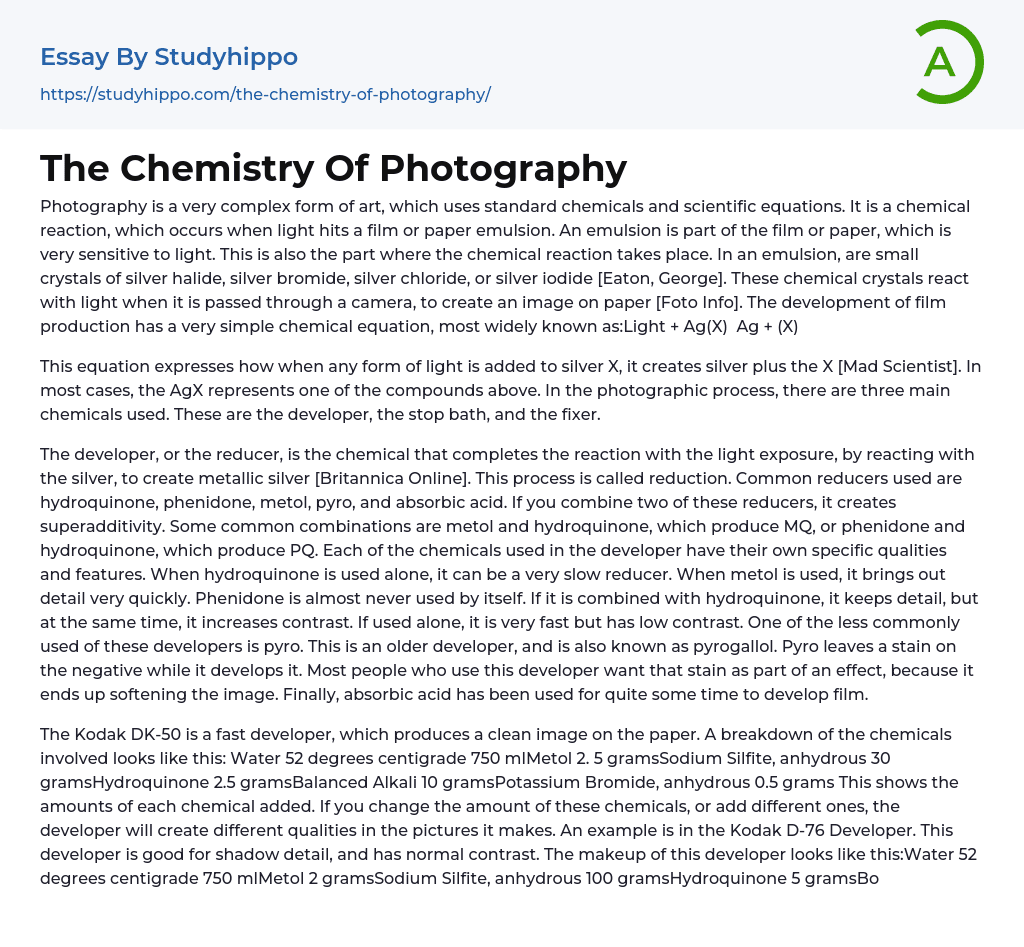Photography is a very complex form of art, which uses standard chemicals and scientific equations. It is a chemical reaction, which occurs when light hits a film or paper emulsion. An emulsion is part of the film or paper, which is very sensitive to light. This is also the part where the chemical reaction takes place. In an emulsion, are small crystals of silver halide, silver bromide, silver chloride, or silver iodide [Eaton, George]. These chemical crystals react with light when it is passed through a camera, to create an image on paper [Foto Info]. The development of film production has a very simple chemical equation, most widely known as:Light + Ag(X) Ag + (X)
This equation expresses how when any form of light is added to silver X, it creates silver plus the X [Mad Scientist].
...In most cases, the AgX represents one of the compounds above. In the photographic process, there are three main chemicals used. These are the developer, the stop bath, and the fixer.
The developer, or the reducer, is the chemical that completes the reaction with the light exposure, by reacting with the silver, to create metallic silver [Britannica Online]. This process is called reduction. Common reducers used are hydroquinone, phenidone, metol, pyro, and absorbic acid. If you combine two of these reducers, it creates superadditivity. Some common combinations are metol and hydroquinone, which produce MQ, or phenidone and hydroquinone, which produce PQ. Each of the chemicals used in the developer have their own specific qualities and features. When hydroquinone is used alone, it can be a very slow reducer. When metol is used, it brings out detail
very quickly. Phenidone is almost never used by itself. If it is combined with hydroquinone, it keeps detail, but at the same time, it increases contrast. If used alone, it is very fast but has low contrast. One of the less commonly used of these developers is pyro. This is an older developer, and is also known as pyrogallol. Pyro leaves a stain on the negative while it develops it. Most people who use this developer want that stain as part of an effect, because it ends up softening the image. Finally, absorbic acid has been used for quite some time to develop film.
The Kodak DK-50 is a fast developer, which produces a clean image on the paper. A breakdown of the chemicals involved looks like this: Water 52 degrees centigrade 750 mlMetol 2. 5 gramsSodium Silfite, anhydrous 30 gramsHydroquinone 2.5 gramsBalanced Alkali 10 gramsPotassium Bromide, anhydrous 0.5 grams This shows the amounts of each chemical added. If you change the amount of these chemicals, or add different ones, the developer will create different qualities in the pictures it makes. An example is in the Kodak D-76 Developer. This developer is good for shadow detail, and has normal contrast. The makeup of this developer looks like this:Water 52 degrees centigrade 750 mlMetol 2 gramsSodium Silfite, anhydrous 100 gramsHydroquinone 5 gramsBorax 2 grams
A stop bath makes sure the developer does not develop any more than it should, by stopping it [Britannica Online]. This is needed because there is always some extra developer in the emulsion. A developer has a pH higher than seven, and is therefore a base. Most photographers use acetic
acid as their stop baths [Foto Info]. This acid neutralizes the developer, causing it to stop. Another simple stop bath is water. The only problem with this is that water will not stop the development of the photo instantly. This is generally not a problem, unless the artist has a specific look that they are trying to achieve. The last chemical in the photography process is the fixer. The fixer breaks up the un-exposed silver salts in the emulsion. Then, you will be able to view the photograph outside of the darkroom, because it will no longer have a chemical reaction with the light. There are six components of the fixer. They are the solvent, the fixing agent, acid, preservative, hardener, and the buffer [Woodson, Roger]. The solvent is usually water, which dissolves the chemicals, including the silver thiosulfate complexes that were formed.
The fixing agent is usually sodium thiosulfate or ammonium thiosulfate. The difference between the two is that sodium thiosulfate is a powder. Ammonium thiosulfate is a liquid, which is easier to mix. It also works much faster. Acetic acid is also used in the development of pictures in the fixer to maintain acidity [Sun Spot]. The preservative is usually sodium sulfite, or Na2SO3. This is used to make the decomposition of thiosulfate weaker. The hardener prevents swelling or softening of the emulsion, which might damage the photograph while you wash it. Finally, the buffer makes it so the fixer does not become too basic. Once again, acetic acid is usually the buffer, when mixed with some sodium thiosulfate. [Sucsy, Arthur] When all this is complete, the photo should be soaked in a water
bath. This will wash off the fixer or silver from the emulsion. If this step is not done, fading and even a loss of color can occur. Another reason the photograph may have problems is if you let the temperature of the chemicals during the process go below 65 degrees. Below this temperature, the chemicals will not function properly, and may not have a reaction. [Foto Info] If there is no reaction, then there is no picture image displayed on the paper.
- Acid essays
- Calcium essays
- Carbohydrate essays
- Carbon essays
- Chemical Bond essays
- Chemical Reaction essays
- Chemical reactions essays
- Chromatography essays
- Concentration essays
- Copper essays
- Diffusion essays
- Ethanol essays
- Hydrogen essays
- Organic Chemistry essays
- Osmosis essays
- Periodic Table essays
- Ph essays
- Salt essays
- Sodium essays
- Titration essays
- Architecture essays
- Design essays
- Graffiti essays
- Graphic essays
- Interior design essays
- Painting essays
- Photography essays
- Sculpture essays
- Typography essays




